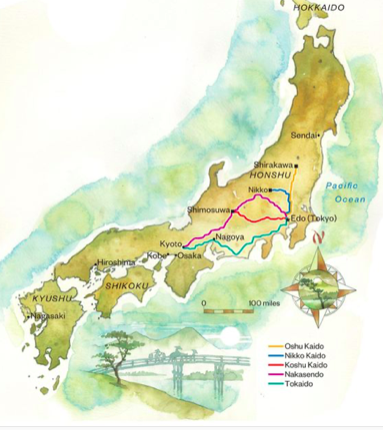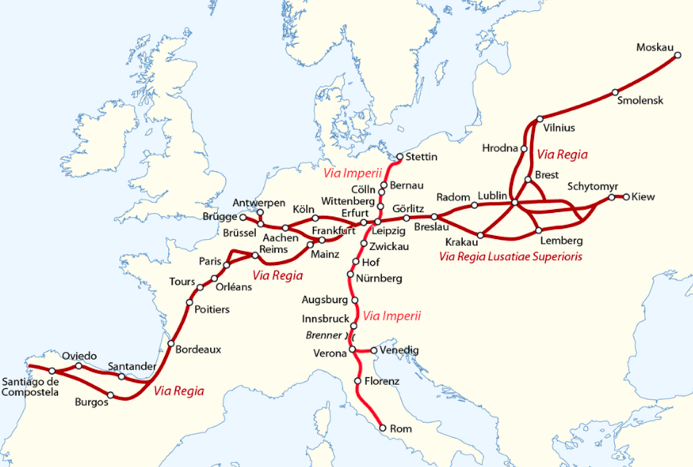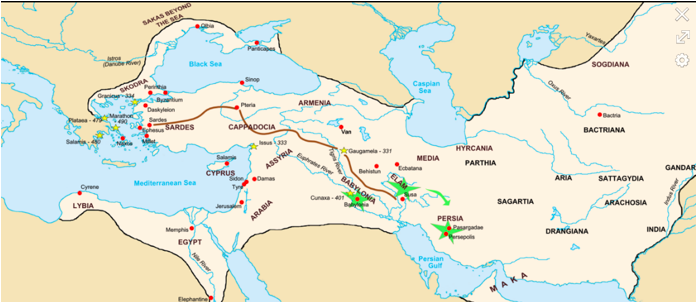 Nakasendo trail is shown in purple. Artist, Steve Stankiewicz.
Nakasendo trail is shown in purple. Artist, Steve Stankiewicz. Roger M McCoy
Rulers of empires had good reason to develop roads to various parts of the realm: to nurture trade within and beyond their empires and to maintain control by movement of armies as necessary.
Both motives applied to the Caminos Reales described in an earlier blog. For example, Spain and later Mexico needed to make sure all the territories in Tejas and America del Norte recognized that the central authority over them was in Mexico City. Furthermore they needed to provide a convenient route for transfer of goods in both directions. Likewise one of the oldest trails is the Silk Road used by tradesmen carrying goods from East Asia to Persia, Syria, and later to Europe (see blog 4/21/2019). Other trails were developed by a king or emperor and given the name Royal Road, and four examples in Europe and Asia will round out the image of trading trails.
In Europe many short trails eventually became two long routes designated as Royal Roads--Via Regia and Via Imperii. The Via Regia eventually reached from San Juan de Compostela, Spain to Moscow, Russia. The Via Imperii went from the Baltic Sea to Rome. They are called Royal Roads because they were sanctioned by the Holy Roman Emperor. Tolls were collected at various points along the way and some protection was provided for travelers.
Via Regia (Royal Road)
Although the European route known as Via Regia began in the eighth century A.D. the first written mention of it was in 1252. The route was important for its major economic importance linking east and west Europe. From the west came Flemish woolen blankets, from the east came wood, pelts, wax, and honey. The middle region provided an indigo plant, valued as a dark blue dye, as well as the mining products of nearby mountains. Indigo was among the earliest dyes to be used for textile dyeing and was highly valued by early Greeks and Romans.
The road was repeatedly used by conquering or retreating armies, and Napoleon’s army trekked the Via Regia during its disastrous return from Russia during the winter of 1812. Today parts of the route are followed by major highways in Germany and Poland. Although the route has been altered somewhat as transportation methods and population pattern changed, the same corridor is now used by the railroad and highways through Germany and Poland.
Via Imperii
Another important trade route went from Rome across the Brenner Pass in Switzerland to the then-German city of Stettin (today the Polish city of Szczecin). Stettin, a port on the Baltic sea, and several other major cities along this route had “staple rights.” These rights required merchants transporting goods to unload their goods and make them available to local customers for three days before packing up and moving on. This right became extremely important for the economic prosperity of major cities, which became known as market towns, and many today have a weekly market day in the town square.
The Persian Royal Road
Another important trading route designated by a king extended from Susa (in present day western Iran) to Sardis, which is now a ruin near present day Salihli, in western Turkey. This important road covered a distance of more than 1600 miles. King Darius established this road during the first Persian Empire (called the Achaemenid Empire) by developing existing ancient trails in the fifth century BCE. As with other Royal Roads this one improved communication and trade throughout the immense Persian empire.
Like an early version of the Pony Express, mounted couriers traveled from Susa to Sardis in nine days—a journey that took ninety days on foot. Herodotus, a contemporary Greek historian, wrote, "There is nothing in the world that travels faster than these Persian couriers." In his praise for these messengers he said, “Neither snow nor rain nor heat nor gloom of night stays these couriers from the swift completion of their appointed rounds.” Readers will recognize this statement that became the creed of the United States Postal Service.
Caravan travel is much slower than a mounted courier and over such a great distance usually took months to complete. For that reason King Darius built many stopping points called caravanserai with accommodations for men and camels to rest. Caravanserai is an early Persian word meaning caravan palace and denotes a building with an enclosed court. In Turkey and the eastern Mediterranean lands such a stopping point was called a Han. Caravanserai also existed along the Silk Road (see blog of 4/21/2019).
Herodotus continued his praise of the road and its many stopping points. He wrote, "Now the true account of the road in question is the following: Royal stations exist along its whole length, and many excellent caravanserai; and throughout, it traverses an inhabited tract, and is free from danger.”
Nakasendo Trail in Japan.
In the seventeenth century Japan underwent many cultural changes. One major change was the renovation of Japan's thousand-year-old highway system. An important part of this renovation was the designation of five routes which became the official roads of the feudal lords (daimyo) and military dictators (shoguns). This road network provided greater communications needed to stabilize and rule the country. Until the establishment of these formal trade routes, many shorter routes existed between towns, but not as a single network. One of these five roads was the Nakasendo, which stretched between Edo (now Tokyo), the center of shogun power, through the central mountain ranges to the ancient capital, Kyoto.
One characteristic of the Nakasendo Trail is the beautiful landscape that it traverses. A Japanese poet, Kobayashi Issa (1763-1828) walked the Nakasendo Trail at night and wrote a Haiku of his impression of its beauty.
Flowing right in
to the Kiso Mountains:
the Milky Way.
Sources:
Schutyser, Tom. Caravanserai: Traces, Places, Dialogue in the Middle East.
5Continents. 2019.
Caravanserai. Retrieved from: en.wikipedia.org/wiki/Caravanserai.
Leipzig. Retrieved from: en.wikipedia.org/wiki/Leipzig
Nakasendo Trail. Retrieved from: en.wikipedia.org/wiki/Nakasendo
Perrottet, Tony. The Way of The Shogun. Smithsonian Magazine. vol 51. no. 04. July 2020. pg 72.
Royal Road Persia to Turkey. Retrieved from en.wikipedia.org/wiki/Royal_Road.
Via Imperii. Retrieved from: en.wikipedia.org/wiki/Via_Imperii.
Via Regia. Retrieved from: en.wikipedia.org/wiki/Via_Regia.
Rulers of empires had good reason to develop roads to various parts of the realm: to nurture trade within and beyond their empires and to maintain control by movement of armies as necessary.
Both motives applied to the Caminos Reales described in an earlier blog. For example, Spain and later Mexico needed to make sure all the territories in Tejas and America del Norte recognized that the central authority over them was in Mexico City. Furthermore they needed to provide a convenient route for transfer of goods in both directions. Likewise one of the oldest trails is the Silk Road used by tradesmen carrying goods from East Asia to Persia, Syria, and later to Europe (see blog 4/21/2019). Other trails were developed by a king or emperor and given the name Royal Road, and four examples in Europe and Asia will round out the image of trading trails.
In Europe many short trails eventually became two long routes designated as Royal Roads--Via Regia and Via Imperii. The Via Regia eventually reached from San Juan de Compostela, Spain to Moscow, Russia. The Via Imperii went from the Baltic Sea to Rome. They are called Royal Roads because they were sanctioned by the Holy Roman Emperor. Tolls were collected at various points along the way and some protection was provided for travelers.
Via Regia (Royal Road)
Although the European route known as Via Regia began in the eighth century A.D. the first written mention of it was in 1252. The route was important for its major economic importance linking east and west Europe. From the west came Flemish woolen blankets, from the east came wood, pelts, wax, and honey. The middle region provided an indigo plant, valued as a dark blue dye, as well as the mining products of nearby mountains. Indigo was among the earliest dyes to be used for textile dyeing and was highly valued by early Greeks and Romans.
The road was repeatedly used by conquering or retreating armies, and Napoleon’s army trekked the Via Regia during its disastrous return from Russia during the winter of 1812. Today parts of the route are followed by major highways in Germany and Poland. Although the route has been altered somewhat as transportation methods and population pattern changed, the same corridor is now used by the railroad and highways through Germany and Poland.
Via Imperii
Another important trade route went from Rome across the Brenner Pass in Switzerland to the then-German city of Stettin (today the Polish city of Szczecin). Stettin, a port on the Baltic sea, and several other major cities along this route had “staple rights.” These rights required merchants transporting goods to unload their goods and make them available to local customers for three days before packing up and moving on. This right became extremely important for the economic prosperity of major cities, which became known as market towns, and many today have a weekly market day in the town square.
The Persian Royal Road
Another important trading route designated by a king extended from Susa (in present day western Iran) to Sardis, which is now a ruin near present day Salihli, in western Turkey. This important road covered a distance of more than 1600 miles. King Darius established this road during the first Persian Empire (called the Achaemenid Empire) by developing existing ancient trails in the fifth century BCE. As with other Royal Roads this one improved communication and trade throughout the immense Persian empire.
Like an early version of the Pony Express, mounted couriers traveled from Susa to Sardis in nine days—a journey that took ninety days on foot. Herodotus, a contemporary Greek historian, wrote, "There is nothing in the world that travels faster than these Persian couriers." In his praise for these messengers he said, “Neither snow nor rain nor heat nor gloom of night stays these couriers from the swift completion of their appointed rounds.” Readers will recognize this statement that became the creed of the United States Postal Service.
Caravan travel is much slower than a mounted courier and over such a great distance usually took months to complete. For that reason King Darius built many stopping points called caravanserai with accommodations for men and camels to rest. Caravanserai is an early Persian word meaning caravan palace and denotes a building with an enclosed court. In Turkey and the eastern Mediterranean lands such a stopping point was called a Han. Caravanserai also existed along the Silk Road (see blog of 4/21/2019).
Herodotus continued his praise of the road and its many stopping points. He wrote, "Now the true account of the road in question is the following: Royal stations exist along its whole length, and many excellent caravanserai; and throughout, it traverses an inhabited tract, and is free from danger.”
Nakasendo Trail in Japan.
In the seventeenth century Japan underwent many cultural changes. One major change was the renovation of Japan's thousand-year-old highway system. An important part of this renovation was the designation of five routes which became the official roads of the feudal lords (daimyo) and military dictators (shoguns). This road network provided greater communications needed to stabilize and rule the country. Until the establishment of these formal trade routes, many shorter routes existed between towns, but not as a single network. One of these five roads was the Nakasendo, which stretched between Edo (now Tokyo), the center of shogun power, through the central mountain ranges to the ancient capital, Kyoto.
One characteristic of the Nakasendo Trail is the beautiful landscape that it traverses. A Japanese poet, Kobayashi Issa (1763-1828) walked the Nakasendo Trail at night and wrote a Haiku of his impression of its beauty.
Flowing right in
to the Kiso Mountains:
the Milky Way.
Sources:
Schutyser, Tom. Caravanserai: Traces, Places, Dialogue in the Middle East.
5Continents. 2019.
Caravanserai. Retrieved from: en.wikipedia.org/wiki/Caravanserai.
Leipzig. Retrieved from: en.wikipedia.org/wiki/Leipzig
Nakasendo Trail. Retrieved from: en.wikipedia.org/wiki/Nakasendo
Perrottet, Tony. The Way of The Shogun. Smithsonian Magazine. vol 51. no. 04. July 2020. pg 72.
Royal Road Persia to Turkey. Retrieved from en.wikipedia.org/wiki/Royal_Road.
Via Imperii. Retrieved from: en.wikipedia.org/wiki/Via_Imperii.
Via Regia. Retrieved from: en.wikipedia.org/wiki/Via_Regia.


 RSS Feed
RSS Feed
